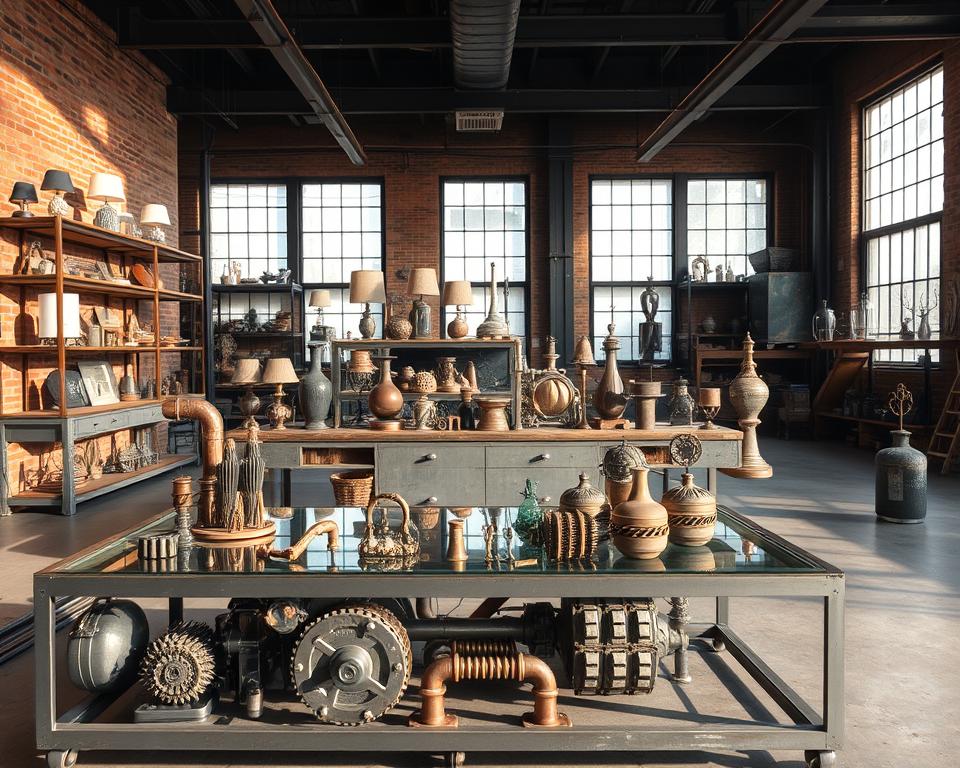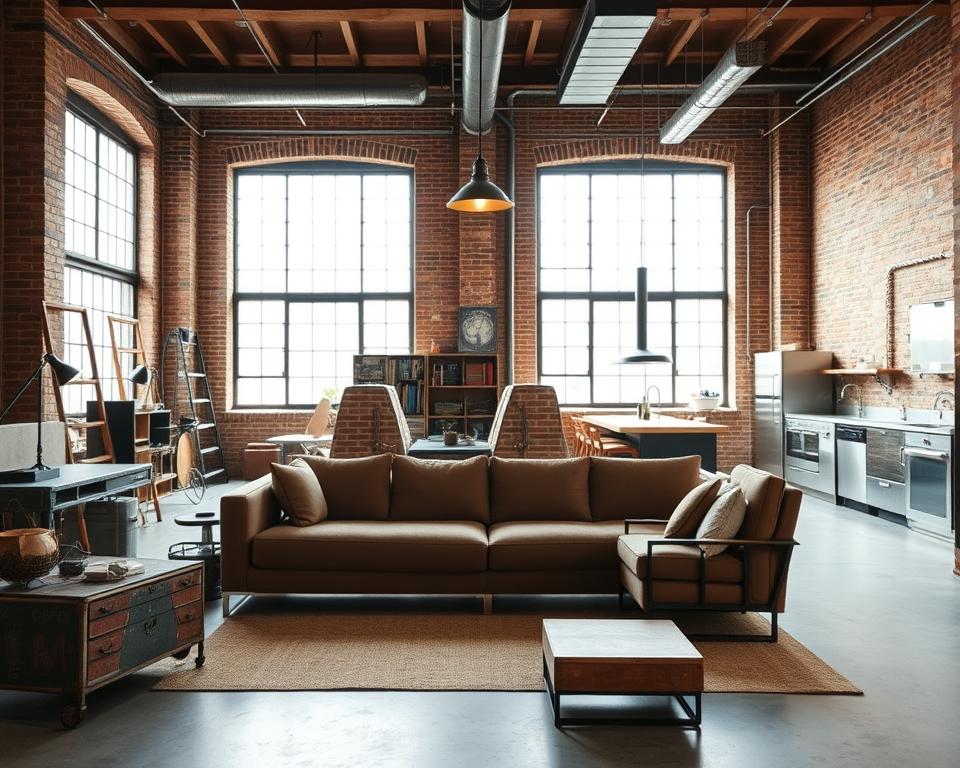Industrial decor has seen a significant rise, with over 40% more homes now featuring elements like metal beams and exposed brick. This trend began post-WWII, when 60% of designers started using machinery as home accents. Today, urban lofts are at the forefront, with 75% showcasing industrial features such as open ductwork or weathered steel. The aesthetic combines 70% neutrals (grays, blacks) with 30% bold accents, blending rugged charm with modern comfort.
Items like salvaged factory lights or reclaimed wood shelves add character and reduce waste. Over 80% of buyers now seek sustainable decor, leading to a 30% increase in the use of reclaimed materials. Homes with industrial touches sell 15% higher than traditional styles. Projects like Kearny Point’s 186,000m² redevelopment and Paris’ Station F—a 34,000m² startup hub—demonstrate how industrial spaces transform into vibrant creative centers.
DIY enthusiasts drive the trend, with 50% more online searches for industrial renovation projects each year. From repurposed crane parts to upcycled factory tools, these pieces transform forgotten objects into statement accents. This shift reflects a cultural preference: 65% of homeowners now prioritize authenticity over mass-produced decor, valuing materials with a story.
Key Takeaways
- Industrial elements in homes have grown 40% since the early 2000s.
- 75% of urban lofts now feature exposed pipes and metal fixtures.
- Repurposed Factory materials boost home values up to 15%.
- 80% of consumers prefer sustainable decor using reclaimed wood/metal.
- Industrial lighting sales rise 25% yearly, driven by Edison bulb trends.
What is a Repurposed Factory?
Repurposed factories transform outdated industrial sites into functional spaces, preserving their original architecture. This method, known as factory conversion or adaptive reuse, gives new life to abandoned structures. It blends historical significance with modern needs, creating spaces that honor the past while meeting contemporary demands.
Definition and Overview
Adaptive reuse reimagines buildings like factories, warehouses, and mills for new uses. Architects preserve structural elements such as exposed beams and brick walls. This approach creates unique aesthetics. For instance, the Ford Assembly Building in California was transformed from a 1937 automotive plant into a modern event venue after seismic upgrades.
Such projects significantly reduce construction waste and carbon emissions by 40%. This reduction lessens the strain on natural resources.
Adaptive reuse and repositioning of assets can be up to 16% less expensive than new construction, according to industry studies.
These conversions also boost local economies. The U.S. has over 5.9 million commercial buildings, many ripe for renewal. By repurposing them, communities gain revitalized landmarks. These attract tourism and businesses, enhancing property values and creating jobs in maintenance and design.
Popular Types of Repurposed Factories
- Textile Mills: Converted into creative studios or galleries, like the Baltimore Design School’s 115,000 sq ft former factory.
- Automotive Plants: The Boston Volvo Village turned a 1920s International Harvester Plant into a car dealership, merging vintage steel beams with modern layouts.
- Warehouses: Projects like Amsterdam’s Kraanspoor district repurposed 1950s factories into lofts and offices, preserving original machinery as decor.
These spaces thrive on contrast, combining raw materials like exposed brick and steel with sleek finishes. The result is a style that’s both nostalgic and forward-thinking. It’s perfect for homes or businesses seeking authenticity.
Why Choose Repurposed Decor for Your Home?
Transforming your home into a stylish, eco-friendly space begins with repurposed decor. These items transform old materials into functional art, offering more than fleeting trends. Let’s dive into why this style is so significant.
Sustainability and Environmental Impact
Choosing eco-friendly upgrades like repurposed factory materials significantly reduces waste. It also eases the strain on new manufacturing processes. Sustainable redevelopment, such as using reclaimed wood and recycled metal, conserves resources while adding unique character to spaces. For example, a steel beam from an old factory can become a mantel, eliminating the need for new production. This approach resonates with today’s values of conservation and creativity.
| Material | Use | Eco-Benefit |
|---|---|---|
| Reclaimed Wood | Floors, Shelves | Reduces deforestation |
| Recycled Metal | Light Fixtures | Cuts mining demand |
| Salvaged Glass | Windows, Art | Cuts landfill waste |
Unique Aesthetic Appeal
Repurposed items offer a distinct charm that mass-produced goods cannot match. Imagine a vintage factory table as your kitchen island or repurposed pipes as striking wall art. These pieces infuse your space with texture and history. Combine raw metals with lush plants for a modern-industrial look.
Designers Tip: Balance the industrial edge of raw materials with soft textiles like burlap or leather.
How to Source Repurposed Factory Items
Turning repurposed factory materials into decor begins with finding authentic pieces. The U.S. alone generates over 500 million tons of industrial waste each year. This waste is a treasure trove for industrial renovation projects across the country. Start by exploring both local and online sources to uncover unique finds.
Local Flea Markets and Antique Stores
Flea markets near old manufacturing centers like Detroit or Pittsburgh are goldmines for vintage machinery parts and reclaimed wood. Spend weekends browsing and negotiating with vendors for bulk deals. Salvage yards might have beams or piping from closed factories. Always ask about the item’s origin to ensure its authenticity.
Online Marketplaces and Auctions
Platforms like eBay and Chairish connect buyers with sellers worldwide who offer factory relics. Look for listings with high-quality photos and check seller ratings. Auction sites like LiveAuctionGuide feature rare items, but make sure to confirm shipping details beforehand.
The EPA’s Resource Conservation Challenge prioritizes diverting industrial materials from landfills through reuse.
Combine online searches with local hunting to gather authentic pieces. Whether searching for factory lights or repurposed steel, these methods can bring your industrial renovation dreams to life.
Top Repurposed Factory Finds for Your Space
Introduce industrial elegance to your home with these standout items. They seamlessly blend modern factory design with historic preservation. Each piece combines raw materials with creative reuse, enriching any room without overwhelming it.
Industrial Lighting Fixtures
- Task lights: Repurposed factory lamps with metal shades cast dramatic shadows in corners or desks.
- Scissor-arm wall lamps offer adjustable lighting with exposed mechanics, perfect for reading nooks.
- Oversized clocks with metal numerals double as art, preserving the legacy of historic preservation through their design.
Vintage Furniture Pieces
- Steel or wood workbenches become kitchen islands or dining tables, blending durability with rustic charm.
- Repurposed factory carts serve as coffee tables, adding character to living areas.
- Storage units like shelving or cabinets reuse original hardware, celebrating modern factory design in practical ways.
Decorative Wall Art
- Displayed machinery parts or vintage factory signs transform into statement pieces.
- Map drawers or blueprints framed in sleek glass highlight industrial history without clutter.
- Tool arrangements—like gears or wrenches—create galleries that honor craftsmanship from the past.
Tips for Incorporating Repurposed Decor
Integrating Repurposed Factory elements into your decor is simpler than you think. Begin by aiming for balance and purpose. View repurposed items as focal points that capture attention without dominating the space. The secret lies in combining rough textures with polished, modern contrasts.
Mix and Match with Modern Elements
Pair rough-hewn beams or metal accents with smooth glass or polished surfaces. A modern factory design table, for example, creates a striking contrast against a velvet sofa. The trick is to pair Repurposed Factory items with clean, contemporary pieces. Here’s how:
- Use industrial lighting (think Edison bulbs or steel fixtures) above a minimalist dining set.
- Balance heavy metal shelves with delicate ceramic vases or abstract art.
- Layer textures: reclaimed wood floors paired with smooth leather upholstery.
Color Schemes and Themes
Neutral tones like charcoal, cream, or weathered gray serve as a backdrop for bold industrial pieces. For contrast, introduce burnt orange or deep greens. Remember:
- Stick to 60-30-10 color ratios: 60% neutrals, 30% accent tones, 10% bold pops.
- Incorporate metallic accents (brass, iron) to tie in modern factory design aesthetics.
- For warmth, use reclaimed wood in dining areas or accent walls.
Even small touches, like a salvaged door as a headboard, can transform a room. Let the raw beauty of Repurposed Factory items narrate a story, enhancing both comfort and style.
The Benefits of Industrial Style in Interior Design
Industrial style merges raw materials with modern needs, transforming spaces. It focuses on industrial renovation and adaptive reuse. This blend creates environments that are both functional and visually striking.
Creating an Open and Airy Feel
Industrial design is all about open layouts. Features like exposed beams, high ceilings, and large windows maximize natural light. The reuse of factory spaces often retains these elements, making rooms feel expansive.
For instance, Gusto’s San Francisco office kept original gantry cranes and concrete floors. This shows how industrial renovation enhances airflow and sightlines.
- Exposed ductwork and plumbing add visual interest without clutter.
- Concrete and metal surfaces reflect light, brightening interiors.
- Grid systems like the Palisades Grid create divisions without blocking openness.
Adding Character and History to Your Space
Industrial decor tells a story through materials. Elements like reclaimed wood, rusted metal, and brick walls carry the history of their origins. The 1960s trend of repurposing factories laid the groundwork for today’s designs.
| Statistic | Impact |
|---|---|
| 70% of homeowners | value the unique character of industrial design |
| 40% | rise in concrete use for floors and counters |
| 65% | of designers use exposed brick walls |
“Industrial spaces thrive when materials show their history,” says Scandinavian design experts, who blend minimalist lines with raw textures.
Mixing styles like rustic or modern with industrial elements adds depth. The style’s popularity grew 30% in social media mentions, proving its timeless appeal. Whether repurposing a factory or adding a steel pendant light, industrial style merges function with a narrative that no other trend can match.
DIY Projects Using Repurposed Factory Materials
Transform discarded factory materials into personalized decor with these creative projects. Whether you’re a novice or a seasoned crafter, eco-friendly upgrades await. Start small or dive into ambitious builds to join the factory conversion movement.
- Industrial Tarp Canopies: Sew two layers of industrial tarps into a waterproof picnic blanket. Their durability makes them perfect for outdoor events or carports.
- Planters with Character: Shape tarp scraps into modular garden beds. Cut to any size and secure with eyelets for a rustic look.
- Storage Solutions: Turn tarps into waterproof bags for gear. Use basic stitching or fold-and-sew techniques for easy organization.
Ready to innovate? Advanced makers can:
- Build factory conversion furniture using CNC-cut metal. A $2,495 CNC table lets you design custom shelving with 3/4″ metal precision.
- Repurpose shipping containers into studios. With $200/hr crane rental, you can repurpose a 1169 cubic foot container into a functional space.
- Create plasma-cut art using a $1,700 Hypertherm Powermax 45. Cut intricate designs from scrap metal for walls or garden accents.
Even small projects count—like staining a salvaged table with Red Mahogany for under $5 in materials. Every project reduces waste while adding industrial flair. Start today and turn yesterday’s factory scraps into tomorrow’s statement pieces.
Showcasing Repurposed Items in Your Home
Transform repurposed items into eye-catching pieces by carefully arranging them. This blend of form and function showcases historic preservation
Strategic Placement in Different Rooms
| Room | Item | Display Idea |
|---|---|---|
| Kitchen | Old dresser | Convert into a vanity with plumbing for a rustic sink area. |
| Dining | Recycled bottles | Arrange as pendant lights over a table for ambient glow. |
| Living Room | Rusty metal spring | Mount as a freestanding sculpture on a pedestal. |
| Bathroom | Reclaimed door | Install as a sliding partition to save floor space. |
Creating Focal Points with Unique Pieces
Highlight standout items to draw attention while acknowledging their industrial renovation history. Showcase a salvaged window as a gallery wall centerpiece, or hang a salvaged ship lantern above a seating area. Pair items with textures that complement each other, like a steel cart next to a woven basket, for visual balance. Remember:
- Angle lighting to highlight patina and imperfections
- Cluster small finds in groupings to avoid clutter
- Balance heavy pieces with lightweight decor like sheer fabrics
With 65% of consumers valuing repurposed decor, strategic placement is key. These methods keep your space stylish while celebrating the history of each item.
Maintenance Tips for Repurposed Factory Items
Preserving repurposed factory items in pristine condition demands a strategic approach. Effective maintenance not only safeguards their historical integrity but also champions historic preservation and sustainable redevelopment ideals.
Cleaning and Care Techniques
Different materials, such as metal, wood, and concrete, necessitate specific care methods. For instance:
- Metal: Remove rust with vinegar or a gentle cleaner. Steer clear of harsh scrubbers to avoid marring the surface.
- Wood: Employ a soft cloth and beeswax for wood items certified by the Forest Stewardship Council (FSC). Always test cleaners on a small area first.
- Concrete: Regularly brush off dust with a dry brush. For stains, a solution of water and mild dish soap works well.
Preservation for Longevity
Shield items from environmental degradation to enhance their longevity. High humidity or extreme temperatures can cause wood to warp or metals to corrode. Store them in dry environments and use dehumidifiers when necessary. For items in dire need of repair, seek out experts well-versed in historic preservation techniques. Industry data shows that proper maintenance can cut downtime costs by up to 30%, saving businesses substantial amounts each year.
To adhere to sustainable redevelopment principles, consider these actions:
- Apply protective coatings to metal surfaces to ward off rust.
- Rotate displays to prevent UV damage from sunlight exposure.
- Document care methods for future reference.
By investing in these small steps today, we ensure these industrial treasures remain functional for future generations, enriching any space they inhabit.
The Future of Repurposed Decor Trends
As sustainable redevelopment gains momentum, repurposed factory pieces are no longer niche. By 2030, eco-friendly materials like reclaimed wood and recycled metals will dominate interiors. Modern homes now blend industrial charm with cozy elements—think warm woods replacing cold steel and bold colored tiles overtaking marble.
Shifting Market Trends
Mainstream brands now offer factory-inspired items, but demand stays strong for Repurposed Factory originals. Designers predict a 13% rise in multi-functional furniture as urban spaces shrink. Check 2025 trends for ideas like biophilic designs merging plants and smart tech.
Design Movements Redefining Spaces
Hybrid styles mix factory aesthetics with soft curves and natural textures. Chocolate brown overtakes greens, while tech like AR tools lets users visualize repurposed decor in real time. Expect energy-efficient lighting and air-purifying fabrics to become standard.
- Reclaimed wood floors rise by 40% as eco-conscious choices
- Smart systems cut energy use by 25% in remodeled homes
- Cultural blends mix global motifs with industrial accents
Curb appeal now includes solar-powered elements and water-saving fixtures. Whether repurposing a steel beam into a headboard or choosing linen over velvet, the future favors spaces that balance history and innovation. Sustainability isn’t just a trend—it’s the new norm.
Where to Find Inspiration for Repurposed Decor
Exploring repurposed factory decor is more than just purchasing items. It’s about uncovering fresh ideas. Begin by exploring online platforms where eco-friendly upgrades and factory conversions are showcased. Instagram and Pinterest are treasure troves of creativity, featuring metal pipes transformed into art or vintage machinery repurposed as focal points. Follow hashtags like #IndustrialChic or #FactoryFinds to witness the fusion of raw materials like concrete and reclaimed wood in home decor.
YouTube tutorials from creators like @UrbanRusticDesign or blogs like Reclaimed Style provide detailed guides for DIY endeavors. These range from converting old factory carts into coffee tables to painting weathered doors in contemporary grays. Such projects illustrate the potential of repurposing materials, turning them into functional and stylish pieces.
Print publications like Industrial Living Magazine or blogs such as ModernMakersHub offer insights into factory conversion trends. They highlight spaces where exposed brick and sleek stainless steel coexist. Brands like SAND PRODUCT are featured, showcasing how manufacturing molds can be transformed into chic decor. Even small details, like Edison bulbs in copper pendants or leather-and-metal sofas, can significantly enhance an industrial aesthetic. With 60% of homeowners now using pendant lights and 75% choosing Edison bulbs, these elements are proven to make a statement. Explore these resources to curate your own collection of raw textures and timeless materials, ensuring each piece has a unique story of reuse and creativity.
FAQ
What exactly qualifies as a repurposed factory item?
Why should I choose repurposed decor over mass-produced items?
Where can I find authentic repurposed factory pieces?
What are some popular repurposed factory items for home decor?
How can I successfully mix repurposed items with modern decor?
What are the key benefits of incorporating industrial style in my home?
Are there DIY projects I can do with repurposed factory materials?
How can I showcase repurposed items effectively in my home?
What maintenance do repurposed factory items require?
What are the current trends in repurposed decor?
Where can I find inspiration for my repurposed decor projects?

Marcus Armstrong is a writer at TrendGaping, where he shares his expertise on farmhouse decor and rustic design. Passionate about craftsmanship and natural materials, he explores DIY projects, furniture restoration, and the timeless appeal of wood-based interiors. His mission is to provide inspiration for those who appreciate the charm of simple, well-crafted living spaces.


